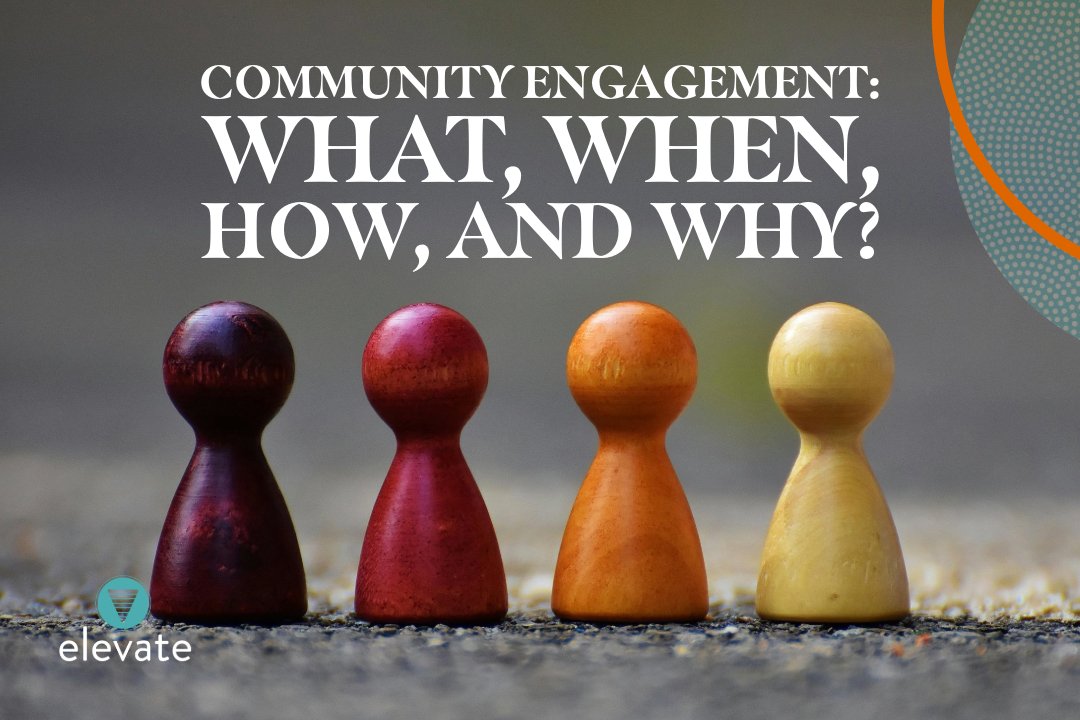Community Engagement: What, When, How, and Why?
Written by Brianna Stephens
in collaboration with Morgan Service and Bailey Via
Community engagement is a longstanding term and practice that evolved from civic engagement principles, emancipatory philosophy, Black-led community organizing, and public health work (Urban Institute, 2021). As social wellbeing and impact became more recognized and valued, community engagement’s significance greatly increased within the nonprofit, public, and private sectors, leaving its application widely spread. It is likely that with such widespread application, people have varied experiences, definitions, and interpretations of community engagement.
Elevate has observed, designed, planned, and supported the implementation of various community engagement strategies and activities. Much of this work falls within our Collaboration and Systems Change service line, however, we find that community engagement and its methods impact our Evaluation and Learning, and Design, Strategy, and Planning work as well. With many avenues for application, we’ll unpack the terms associated with community engagement, potential implementation paths, and pressing challenges and opportunities it faces.
The “What”
You may have heard some of the following terms - and even used them interchangeably - however, they are distinct in nature. While “community” is central to each definition, their applications vary and in practice, mimic a spectrum where equity, commitment, and accountability increase incrementally.
The “When” and “How”
Community engagement is most useful and impactful when executed intentionally. It has greater chances of success when conditions are ideal i.e., organizational and communal capacity and bandwidth are accounted for, the right people are in the right seats guiding the work, and most importantly, there is willingness and trust with the community. You may find that community engagement methods are especially helpful with any or all of the following:
Design and Planning
Ideation: Integrating community voice and assessing needs by engaging your intended audience within the community
How?
Data collection e.g., focus groups, listening sessions, etc.
Implementation
Testing and Iterating: Integrating community involvement and engagement to increase reach and achieve outcomes
When?
Maintenance and improvement
Significant shifts in the plan and/or commitments
How?
Advisory Committees
Leadership positions
Evaluation and Learning: Integrating community voice to assess and improve
How?
Data collection e.g., interviews, surveys, etc.
Policy & Advocacy
All of the above works together, in addition to community ownership, to provide systems-level proof points
The “Why”
Elevate encourages organizations to reflect on their commitments to the community, assess where they can make improvements to their methods, and seek alignment between intent and practice to work toward equitable community engagement. Most organizations have positive intent, but for many reasons, a disconnect between intent and impact can develop. The Spectrum of Community Engagement to Ownership is a resource organizations can use to assess existing practices and to plan for future practices. Generally, we’ve found the following key takeaways as necessary for a path to community engagement success:
Know your why, and ensure it is critical to meeting community needs and goals
Take your time to be intentional in the planning process
Build a team that is bought-in and aligned with goals
Reference field-wide best practice while implementing/establishing unique best practices of your local landscape
Assess and plan with your team - level set on expectations and practice transparency with where you are in the process
Facilitate self and team assessments to mitigate harm and risk
When your plan experiences challenges, remain flexible! Collectively reflect, adapt, and provide change management support
In summary, do community engagement intentionally, equitably, and frequently.


